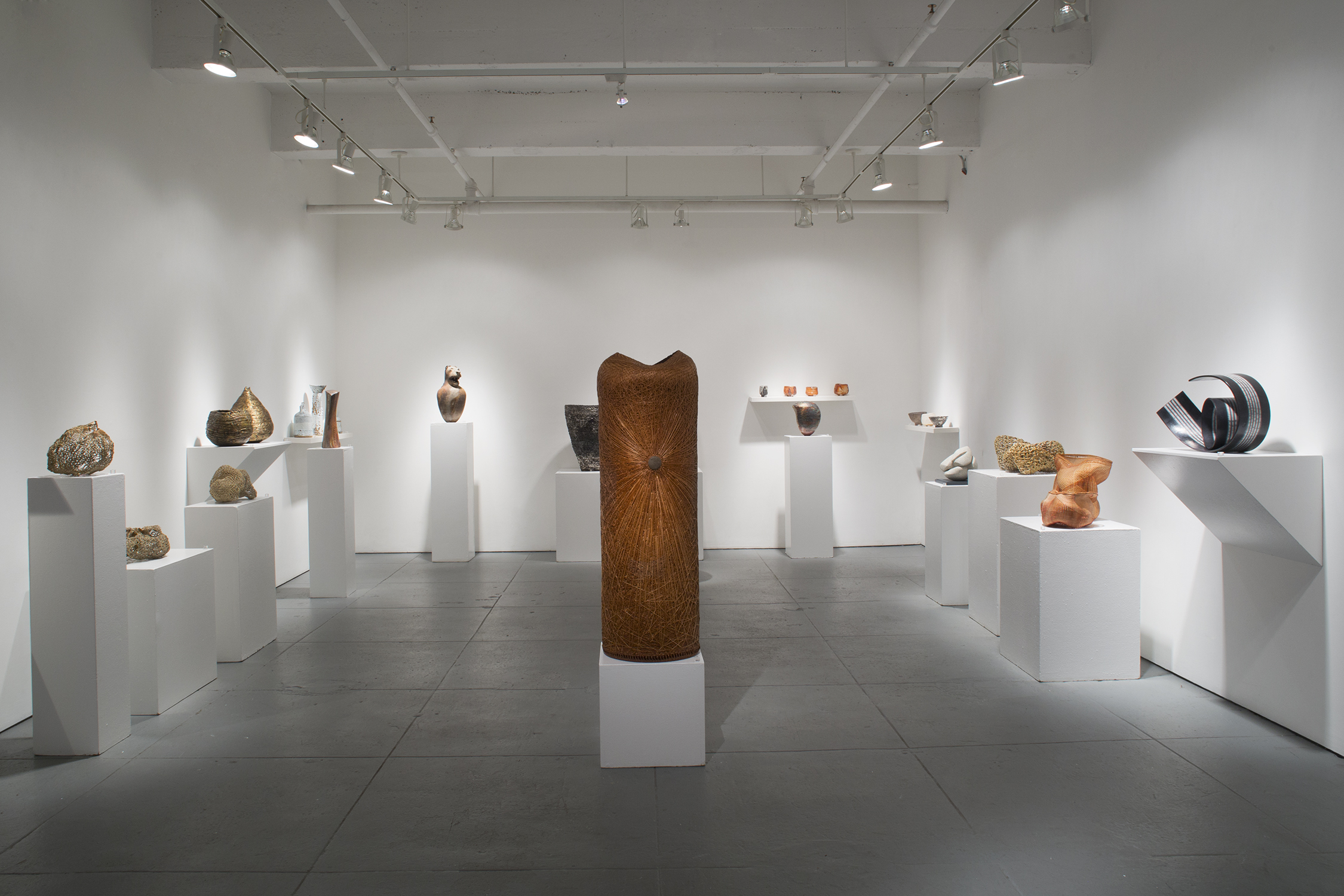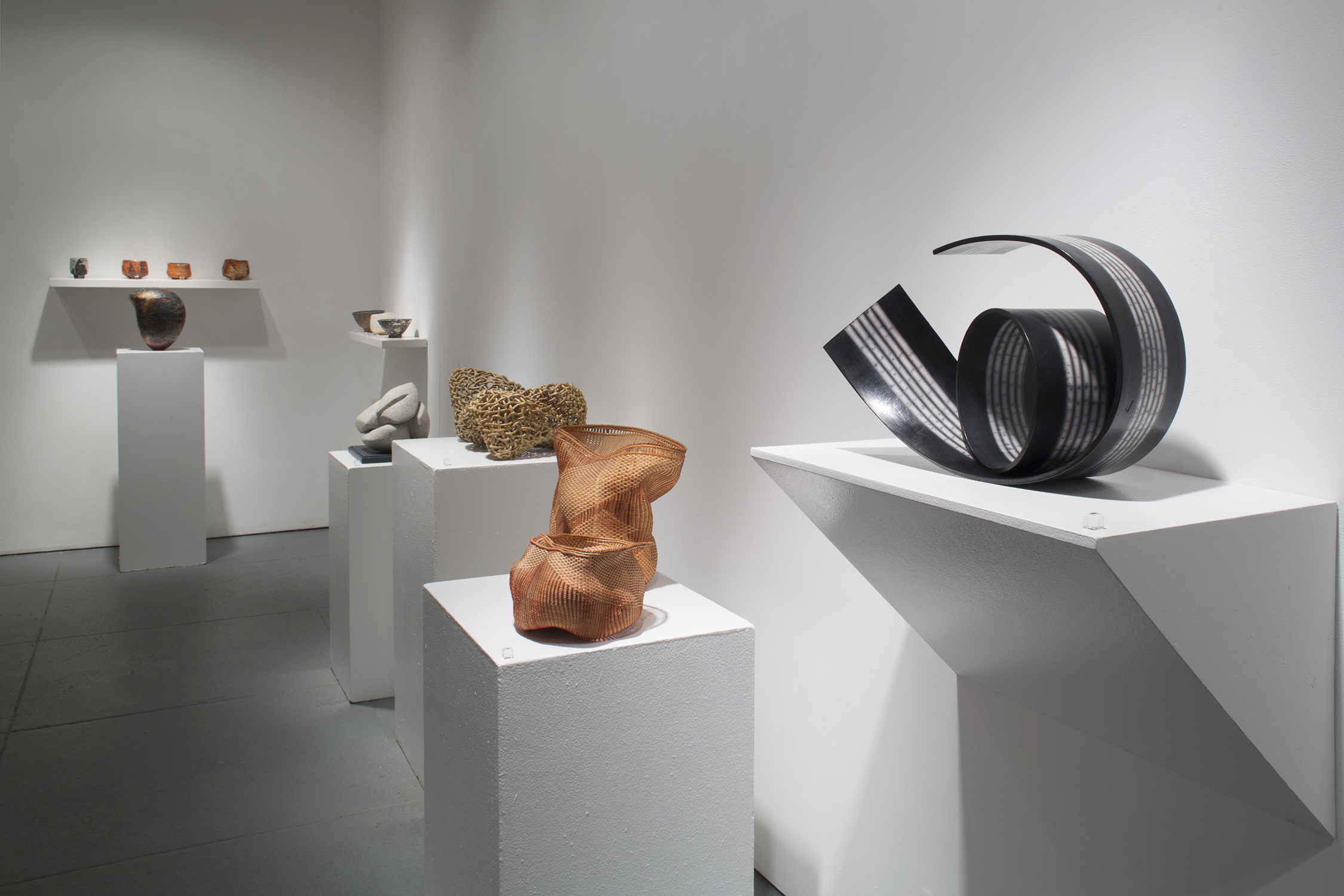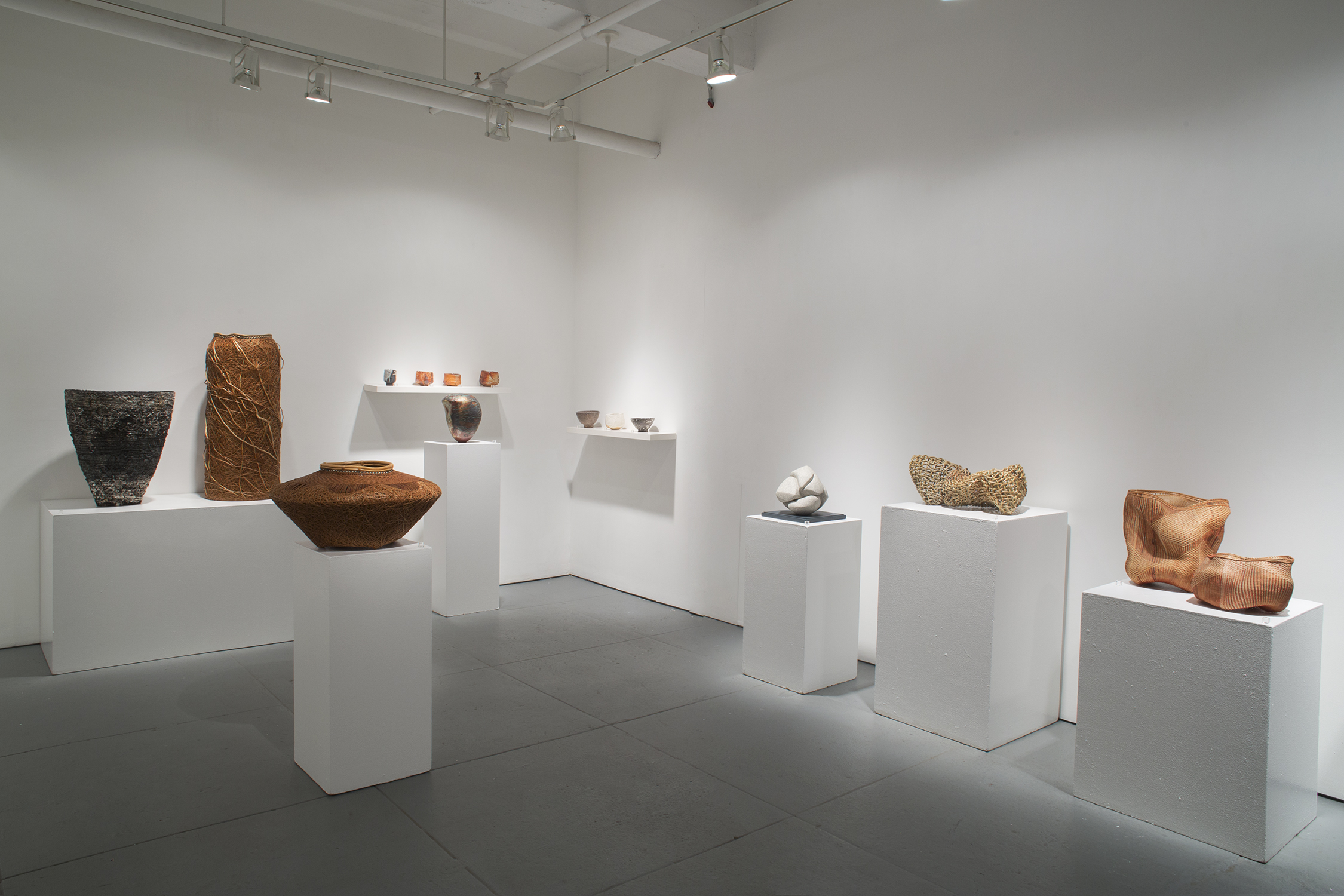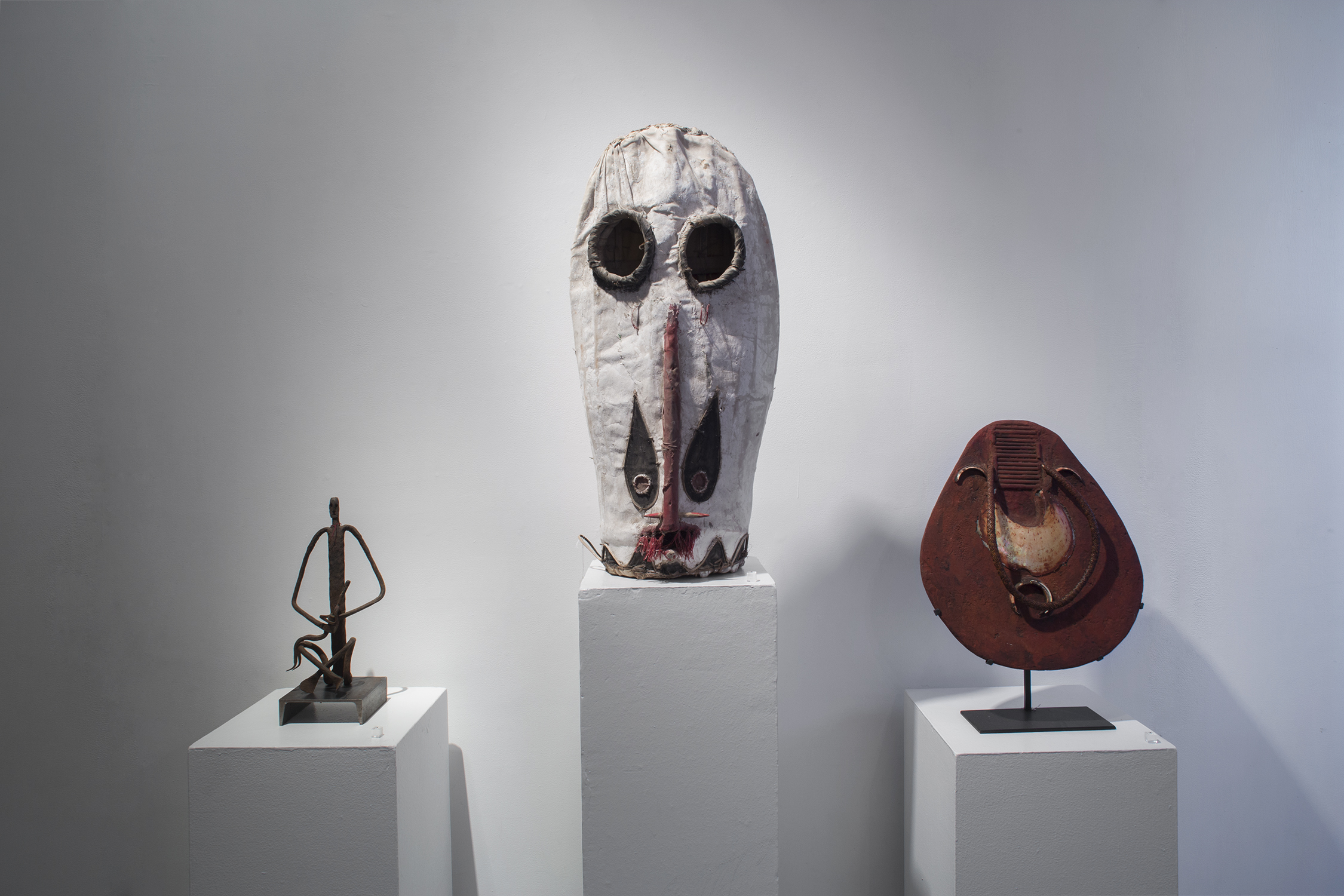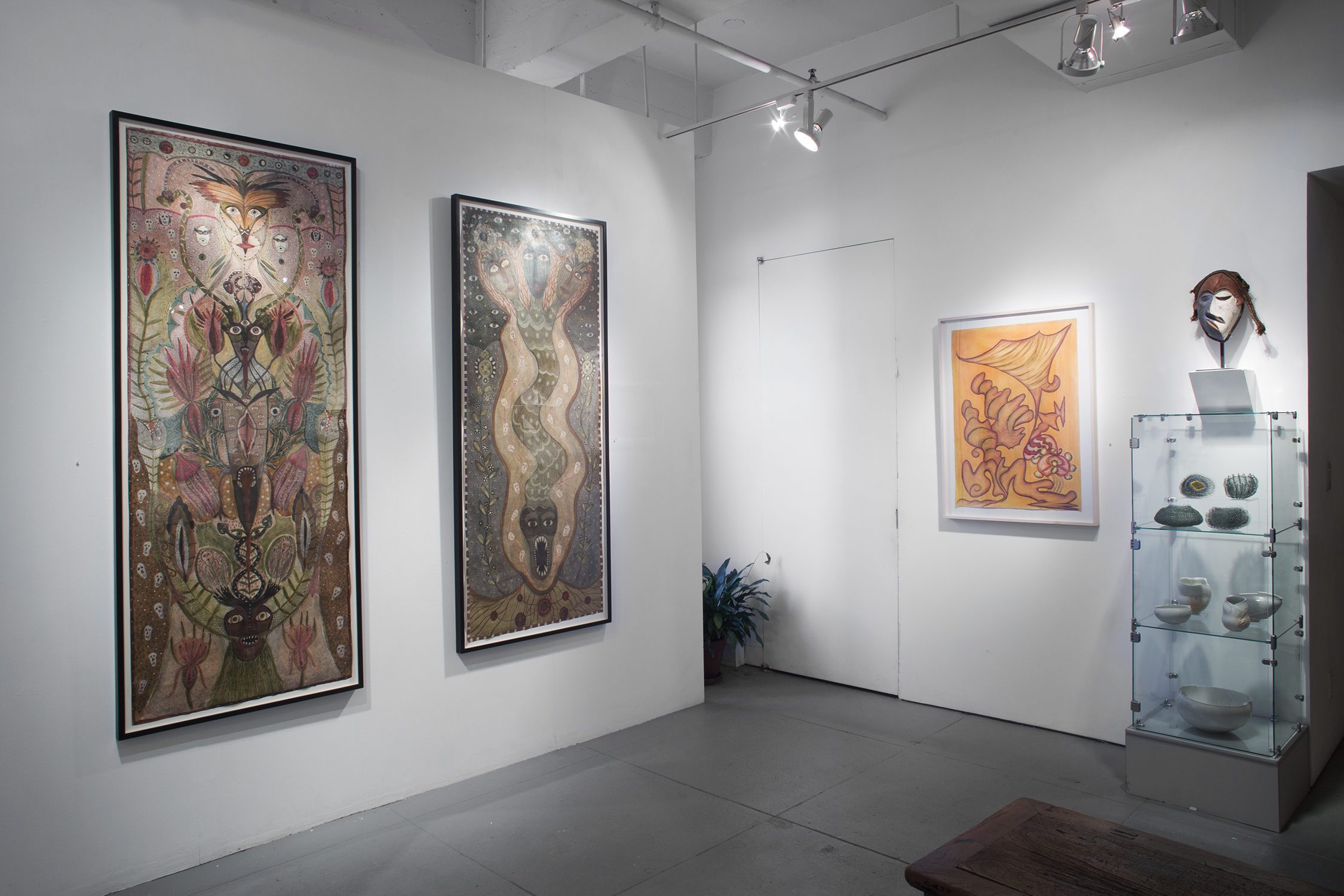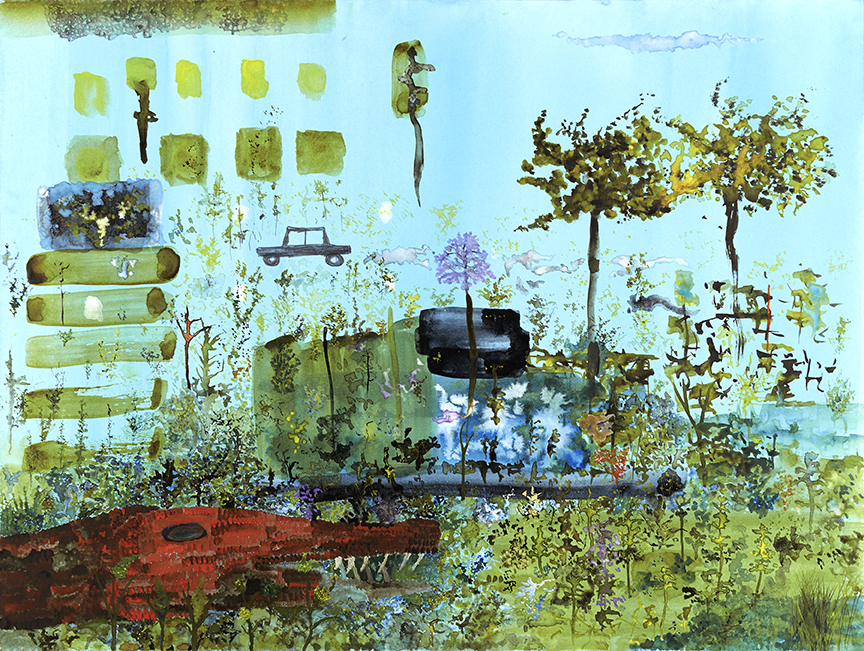Click here to read article.
ENIGMAS RAPT IN MYSTERIES: AMERICAN ART WITHOUT EPOCH
Enigmas Rapt in Mysteries: American Art Without Epoch
December 18, 2014 – February 7, 2015
Timeless is a key word for the great art in this field. It is powerful and relevant no matter when it is seen. It is not tied in any way to the faddism of mainstream art movements. Any work by any artist in this exhibition might have been called Art Brut by Jean Dubuffet back in the day. But in fact there was almost no American material in the original Art Brut collection. The reasons are very simple. At the time Dubuffet was putting together his magnificent collection the work from the Americas was little known. In fact, the only documented exposure really to African-American works were six paintings by the Haitian master Hector Hyppolite, which Andre Breton brought back to Paris and gave to the Compagnie L’Art Brut. He took the paintings back when the collection came to the United States. The field is an organic entity, always changing. As attention began to be paid to idiosyncratic artists who were shapeshifters within their own cultures, or who came from non-European backgrounds and were forced to live in two realities, two cultures simultaneously, Dubuffet’s original concept became locked in time.
The artists in this exhibition were not known to the architects of the Art Brut temple. The word ‘outsider’ has indeed haunted them but it has rendered itself impotent by its inclusion of anything people consider eccentric. We have chosen to curate this exhibition with certain criteria in mind. The criteria are: The artists are self-taught. Not one of them makes work for a mainstream agenda. For all, the process of making the work is of equal or greater importance than the finished piece. None intentionally made work for the art market. Each of them made work to define their own senses of Place, or healing, or spiritual accounting, or self-definition. Even if the work speaks in the language of a culture, we chose those whose forms are little or not at all limited by formal tradition. They are all very American and very iconoclastic.
Although we see African-American work now in the Art Brut Museum in Lausanne and in important Art Brut-oriented collections, African-American art really represents a sort of wild border to the canon decreed by Dubuffet. When push comes to shove, no art in the world can be made outside human culture so we have to go with the assumption that it is only work made outside the Art Mainstream Culture that applies. Even flint-knapping holds the baggage of hunting gathering society. We can never know what Dubuffet really might have felt about the work from the Americas. Surely the African-American inclusion would have made for an amazing discourse. Take, for example, the work of JB Murray, which he originally made as a way of communicating to his community about being spiritually saved or lost, and which was so extreme to some that he was banished from his church, and regarded with suspicion as to his mental state. Later he was welcomed back and even allowed to do some preaching when it was seen that his vision was sincere and his state of spiritual intensity was deemed truly coming from above. So the culture changed and absorbed his iconoclastic intensity.
This work continues to pick up mojo despite the failure to lock it into any consistent definition. It does not fit mainstream criteria. It has no agenda. It has power in its mysteries. And it is not stuck in time. Its forms and intentions are fluid and ever changing.
Artists included are: Chelo González Amezcua, Emery Blagdon, Peter Charlie Besharo, Ras Dizzy, Felipe Jesus Consalvos, Guyodo, Errol McKenzie, J.B. Murray, Melvin Edward Nelson, Norma Oliver, Philadelphia Wireman, Martín Ramírez, Anthony Joseph Salvatore, Jon Serl, Gregory Van Maanen, Helen Butler Wells, Joseph Yoakum, and others.
For further information please contact: Shari Cavin, Caroline Casey, or Marissa Levien at 212-226 3768, or info@cavinmorris.com.
VIVIAN MAIER SPECIAL EXHIBITION
Cavin-Morris Gallery is proud to announce a special exhibition featuring the vintage works of internationally renowned photographer Vivian Maier. This show will feature original vintage Vivian Maier photographs from the collection of Ron Slattery, one of the original buyers of her work.
This is a unique opportunity to experience over 100 of Vivian Maier’s original photos. The show will feature photographs printed during Vivian Maier’s lifetime, documenting her life in the United States and Europe. Many of these images have never been seen before by the public. This is the first time Mr. Slattery’s collection has been shown in New York.
The short exhibition will open on Tuesday, December 9, 2014 at noon and continue through Saturday, December 13, 2014.
For further information please contact Shari Cavin, Caroline Casey, or Marissa Levien at 212-226-3768, or info@cavinmorris.com.
ELEMENTALS: WOMEN SCULPTING ANIMISM
NOVEMBER 1 - DECEMBER 13, 2014
Cavin-Morris is pleased to present an exhibition of living women artists working with ancient concepts and materials in a completely contemporary way.
This exhibition expands on the idea of these artworks being part of a language that expresses the animist essence of life. Animism is a belief in the souls of non-human entities. It is spiritual rather than religious, intuitive rather than empirical. There is a wide range of work in the exhibition from the intellectual intricacies of Phyllis Sullivan’s force webs to the stark almost Neolithic but intensely worked roughness of Sarah Purvey’s urns. Many of the more vessel-like pieces consciously charge the spaces they contain, animating them by concealing them in shadow or stippling them with surface light.
All pieces are in conversation with the Elementals of fire, water, earth and air. It is claimed by some archaeologists that women invented pottery and the weaving of plant materials into textiles and baskets. The mainstream is hesitant about stepping into non-empirical spaces but that is precisely what this exhibition is about; those original forms and processes that have been here forever yet continue to change and mutate into absolutely contemporary statements.
Perhaps this unseen but assumed connection is expressed best in this quote from a Ngarindjeri woman from Australia, Doreen Kartinyeri, explaining the seen and unseen references in her basketry: “…all about the same way…the way we do everything in a circle…a circle that’s tying us all together. It’s binding us together. The tightness of the stitches is like the closeness of the family…when you finish and you’re on the last strand of the rush, that is the filling, and when we do it that way, you can’t see where it ends. And that is the miwi because there is no end to the miwi…to the lifeline.” Miwi is the indigenous word for intangible intuitions, survival and morality and balance in life that is not non-material.
The following artists will have work in this exhibition: Charissa Brock, Chizu Sekiguchi, Polly Adams Sutton, Dawn Walden, Judith Duff, Simcha Even-Chen, Melanie Ferguson, Deirdre Hawthorne, Mami Kato, Touri Maruyama, Sarah Purvey, Jane Wheeler, Monique Rutherford, Phyllis Sullivan, Lisa Hammond, Mieko Kawase, Sally Anderson, Susan Margin, Margaret Yuko Kimura, Nancy Brorby and others.
For further information, please contact the gallery at tel. 212-226-3768, or e: info@cavinmorris.com.
ELEMENTALS: WOMEN SCULPTING ANIMISM
ELEMENTALS: Women Sculpting Animism
November 1 – December 13, 2014
Cavin-Morris is pleased to present an exhibition of living women artists working with ancient concepts and materials in a completely contemporary way.
This exhibition expands on the idea of these artworks being part of a language that expresses the animist essence of life. Animism is a belief in the souls of non-human entities. It is spiritual rather than religious, intuitive rather than empirical. There is a wide range of work in the exhibition from the intellectual intricacies of Phyllis Sullivan’s force webs to the stark almost Neolithic but intensely worked roughness of Sarah Purvey’s urns. Many of the more vessel-like pieces consciously charge the spaces they contain, animating them by concealing them in shadow or stippling them with surface light.
All pieces are in conversation with the Elementals of fire, water, earth and air. It is claimed by some archaeologists that women invented pottery and the weaving of plant materials into textiles and baskets. The mainstream is hesitant about stepping into non-empirical spaces but that is precisely what this exhibition is about; those original forms and processes that have been here forever yet continue to change and mutate into absolutely contemporary statements.
Perhaps this unseen but assumed connection is expressed best in this quote from a Ngarindjeri woman from Australia, Doreen Kartinyeri, explaining the seen and unseen references in her basketry: “…all about the same way…the way we do everything in a circle…a circle that’s tying us all together. It’s binding us together. The tightness of the stitches is like the closeness of the family…when you finish and you’re on the last strand of the rush, that is the filling, and when we do it that way, you can’t see where it ends. And that is the miwi because there is no end to the miwi…to the lifeline.” Miwi is the indigenous word for intangible intuitions, survival and morality and balance in life that is not non-material.
The following artists will have work in this exhibition: Charissa Brock, Chizu Sekiguchi, Polly Adams Sutton, Dawn Walden, Judith Duff, Simcha Even-Chen, Melanie Ferguson, Deirdre Hawthorne, Mami Kato, Touri Maruyama, Sarah Purvey, Jane Wheeler, Monique Rutherford, Phyllis Sullivan, Lisa Hammond, Mieko Kawase, Sally Anderson, Susan Margin, Margaret Yuko Kimura, Nancy Brorby and others.
For further information, please contact the gallery at tel. 212-226-3768, or e: info@cavinmorris.com.
:::ELEMENTALS:::
NOVEMBER 1 - DECEMBER 13, 2014
ELEMENTALS: Women Sculpting Animism
Cavin-Morris is pleased to present an exhibition of living women artists working with ancient concepts and materials in a completely contemporary way.
This exhibition expands on the idea of these artworks being part of a language that expresses the animist essence of life. Animism is a belief in the souls of non-human entities. It is spiritual rather than religious, intuitive rather than empirical. There is a wide range of work in the exhibition from the intellectual intricacies of Phyllis Sullivan’s force webs to the stark almost Neolithic but intensely worked roughness of Sarah Purvey’s urns. Many of the more vessel-like pieces consciously charge the spaces they contain, animating them by concealing them in shadow or stippling them with surface light.
All pieces are in conversation with the Elementals of fire, water, earth and air. It is claimed by some archaeologists that women invented pottery and the weaving of plant materials into textiles and baskets. The mainstream is hesitant about stepping into non-empirical spaces but that is precisely what this exhibition is about; those original forms and processes that have been here forever yet continue to change and mutate into absolutely contemporary statements.
Perhaps this unseen but assumed connection is expressed best in this quote from a Ngarindjeri woman from Australia, Doreen Kartinyeri, explaining the seen and unseen references in her basketry: “…all about the same way…the way we do everything in a circle…a circle that’s tying us all together. It’s binding us together. The tightness of the stitches is like the closeness of the family…when you finish and you’re on the last strand of the rush, that is the filling, and when we do it that way, you can’t see where it ends. And that is the miwi because there is no end to the miwi…to the lifeline.” Miwi is the indigenous word for intangible intuitions, survival and morality and balance in life that is not non-material.
The following artists will have work in this exhibition: Charissa Brock, Chizu Sekiguchi, Polly Adams Sutton, Dawn Walden, Judith Duff, Simcha Even-Chen, Melanie Ferguson, Deirdre Hawthorne, Mami Kato, Touri Maruyama, Sarah Purvey, Jane Wheeler, Monique Rutherford, Phyllis Sullivan, Lisa Hammond, Mieko Kawase, Sally Anderson, Susan Margin, Margaret Yuko Kimura, Nancy Brorby and others.
For further information, please contact the gallery at tel. 212-226-3768, or e: info@cavinmorris.com.
Kevin Blythe Sampson: Ironbound
Artist Kevin Blythe Sampson discusses how his works of art trace the past and present of his hometown neighborhood, known as Ironbound, New Jersey. Ironbound is on view through February 1, 2015 at the John Michael Kohler Arts Center.
OPENING NOVEMBER 1, 2014
ART CHRONICLES #1 — PAINTING WITH JOHN
LAST WEEK OF JOHN LURIE
JOHN LURIE: There Are Things You Don't Know About
Closing on October 25th, 2014.
Community Culture Curator: Strange & Beautiful, the music of John Lurie
Click here to read: Community Culture Curator: Strange & Beautiful, the music of John Lurie
by Richard Oceguera
FLAVORPILL.COM
Interview with John Lurie for VICE MAGAZINE
Click here to read the interview: "John Lurie Doesn't Care Much For Bullshit"
By Charlie Ambler | September 26, 2014
VICE MAGAZINE
JOHN LURIE: There Are Things You Don't Know About
OPENING RECEPTION
SEPTEMBER 18, 2014


